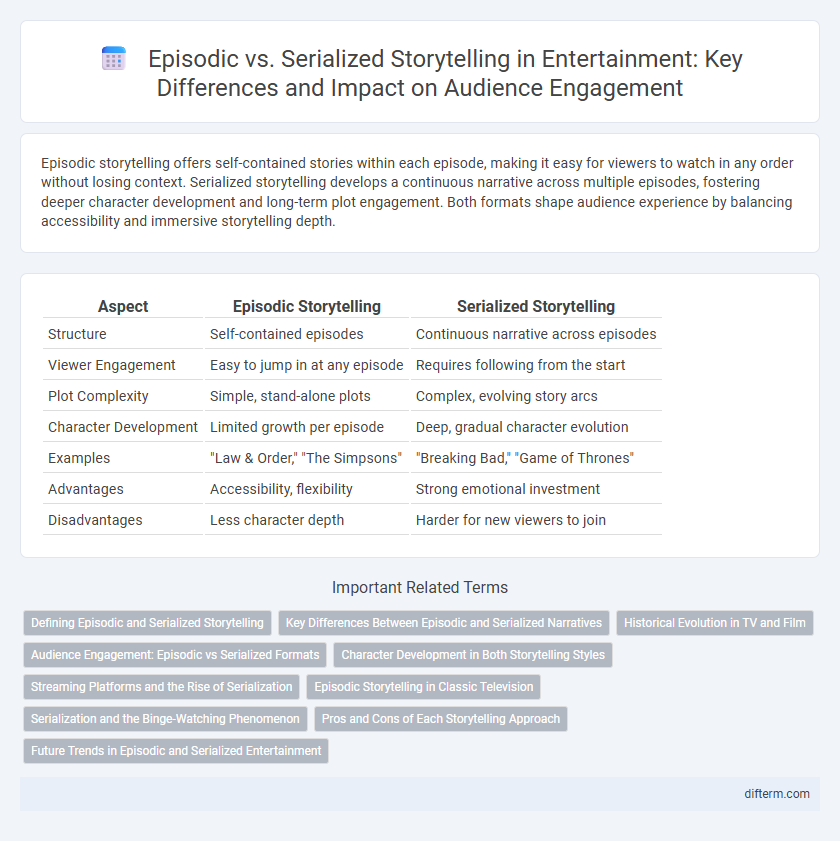Episodic storytelling offers self-contained stories within each episode, making it easy for viewers to watch in any order without losing context. Serialized storytelling develops a continuous narrative across multiple episodes, fostering deeper character development and long-term plot engagement. Both formats shape audience experience by balancing accessibility and immersive storytelling depth.
Table of Comparison
| Aspect | Episodic Storytelling | Serialized Storytelling |
|---|---|---|
| Structure | Self-contained episodes | Continuous narrative across episodes |
| Viewer Engagement | Easy to jump in at any episode | Requires following from the start |
| Plot Complexity | Simple, stand-alone plots | Complex, evolving story arcs |
| Character Development | Limited growth per episode | Deep, gradual character evolution |
| Examples | "Law & Order," "The Simpsons" | "Breaking Bad," "Game of Thrones" |
| Advantages | Accessibility, flexibility | Strong emotional investment |
| Disadvantages | Less character depth | Harder for new viewers to join |
Defining Episodic and Serialized Storytelling
Episodic storytelling features self-contained episodes with a clear beginning, middle, and end, allowing viewers to enjoy each installment independently. Serialized storytelling weaves a continuous narrative across multiple episodes or seasons, requiring consistent viewer engagement to follow character development and intricate plotlines. Both formats shape audience experience, with episodic emphasizing accessibility and serialized prioritizing depth and complexity.
Key Differences Between Episodic and Serialized Narratives
Episodic storytelling features self-contained episodes with distinct plots, allowing viewers to watch in any order without losing comprehension, whereas serialized storytelling weaves a continuous narrative across episodes, requiring sequential viewing for full understanding. Episodic formats emphasize character resets and standalone conflicts, while serialized narratives develop complex character arcs and long-term storylines that build tension and depth. Key differences include audience engagement patterns, narrative complexity, and pacing, with episodic stories often suited for casual viewing and serialized stories catering to dedicated, long-term fan investment.
Historical Evolution in TV and Film
Episodic storytelling dominated early television with shows like "I Love Lucy" emphasizing standalone episodes for easy syndication and mass appeal. The rise of serialized storytelling gained momentum in the late 20th century, exemplified by series like "Hill Street Blues" and "Twin Peaks," which embraced complex character arcs and continuous narratives. Streaming platforms in the 21st century further accelerated serial formats, allowing creators to explore long-term story development and audience binge-watching habits.
Audience Engagement: Episodic vs Serialized Formats
Episodic storytelling fosters audience engagement by offering self-contained stories that allow viewers to drop in at any point without confusion, catering to casual or infrequent viewers. Serialized storytelling builds deeper emotional investment through continuous, interconnected plotlines that reward consistent viewership and create anticipation for future episodes. Data from streaming platforms show serialized formats tend to generate higher binge-watching rates and social media buzz, enhancing long-term audience loyalty.
Character Development in Both Storytelling Styles
Episodic storytelling allows characters to reset or evolve minimally each episode, focusing on distinct, self-contained arcs that emphasize character traits and situational reactions. Serialized storytelling offers continuous character development, enabling deeper exploration of motivations, growth, and long-term conflicts across episodes. This sustained narrative fosters emotional investment and complex character evolution often missing in episodic formats.
Streaming Platforms and the Rise of Serialization
Streaming platforms have accelerated the rise of serialized storytelling by enabling binge-watching and continuous content engagement, which episodic formats struggle to sustain. Serialized narratives on services like Netflix and Amazon Prime foster deeper character development and complex plots, increasing subscriber retention and viewer investment. This shift challenges traditional episodic storytelling by prioritizing long-form story arcs tailored for on-demand consumption patterns.
Episodic Storytelling in Classic Television
Episodic storytelling in classic television emphasizes self-contained episodes with distinct plots, allowing viewers to enjoy shows without prior knowledge of previous episodes. Popular series like "The Twilight Zone" and "I Love Lucy" utilized this format to deliver diverse narratives and character-driven stories in limited timeframes. This structure maximized syndication potential and audience accessibility, contributing to the enduring legacy of classic TV programming.
Serialization and the Binge-Watching Phenomenon
Serialized storytelling creates a continuous narrative across episodes, encouraging viewers to watch multiple installments in a single sitting, fueling the binge-watching phenomenon. Platforms like Netflix and Hulu have popularized this model by releasing entire seasons at once, maximizing audience engagement and subscription retention. The sustained character development and intricate plotlines in serialized series enhance viewer investment, making binge-watching a preferred consumption style in modern entertainment.
Pros and Cons of Each Storytelling Approach
Episodic storytelling offers self-contained narratives in each episode, making it accessible for casual viewers and easy to syndicate, but can lack deep character development and overarching plot complexity. Serialized storytelling provides continuous story arcs that enhance character growth and viewer investment, yet demands consistent viewing, which may alienate new or intermittent audiences. Balancing episodic and serialized elements can maximize audience engagement by combining accessibility with narrative depth.
Future Trends in Episodic and Serialized Entertainment
Future trends in episodic and serialized storytelling emphasize immersive technologies such as virtual reality and augmented reality to create deeper audience engagement. Streaming platforms continue to influence narrative structures by enabling hybrid formats that combine self-contained episodes with overarching story arcs. Data analytics and artificial intelligence are increasingly utilized to tailor content, optimizing viewer retention and personalized storytelling experiences.
Episodic storytelling vs Serialized storytelling Infographic

 difterm.com
difterm.com